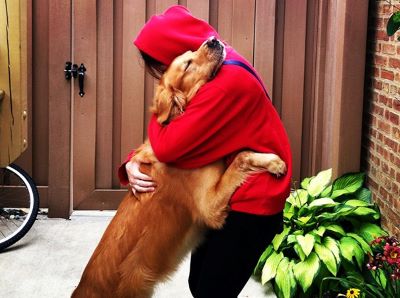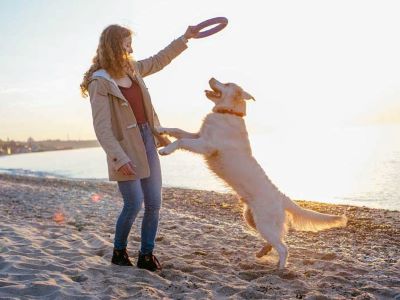Do you own a dog that enjoys standing on you? If so, you are not by yourself. This habit is common among dog owners and their canine companions. Why, though, do they do it? What are they attempting to convey to you? Is it anything nice or something bad?

In this blog post, we will answer these questions and more. We’ll discuss some of the frequent causes of dogs standing on people as well as strategies for dealing with this behavior.
We will also cover some of the finest advice for training your dog to follow directions and respect limits, as well as how to give your dog enough exercise and mental stimulation, praise good conduct, ignore poor behavior, and seek advice from a vet or a dog trainer if the issue persists.
By the end of this post, you will have a better understanding of your dog’s behavior and how to improve your relationship with them.
Contents
Why Does My Dog Stand on Me?
Dogs often seek attention and affection from their owners through behaviors like standing on them. This behavior can stem from various reasons such as their need for attention, display of dominance, seeking comfort, or expressing curiosity and playfulness.
Understanding the underlying motivations behind these actions can help owners establish a balanced and respectful relationship with their dogs.[1]
1. Attention Seekers
- If you have a dog, you know how much they love to be around you. They may jump on your lap, nuzzle your face, or even stand on you when you sit down.
- This is their way of saying “I love you” and “I miss you”. They may also want some cuddles or warmth from you. Some dogs may stand on you to greet you or show their loyalty .
- While this behavior may be cute and harmless, it can also be a sign that your dog needs more attention and stimulation from you.
- To prevent your dog from standing on you for attention, you should spend quality time with them every day, play with them, and ignore them when they act needy.

2. Dominant Dogs
- Some dogs may have a strong personality and a desire to be the boss. They may stand on you to show that they are the leader and that you are the follower.[2]
- They may also want to mark you as their property and ward off other dogs. This behavior may come from a lack of training, socialization, or confidence.
- While this behavior may not be malicious, it can also be a problem if your dog becomes aggressive or disrespectful.
- To teach your dog to respect you and your boundaries, you should be the leader of the pack, by setting rules and limits, using positive reinforcement, and providing consistent guidance.
3. Anxious Pups
- Some dogs may have a sensitive nature and a fear of the unknown. They may stand on you when they are scared or nervous about something.
- They may need your comfort and protection from a potential threat, such as a loud noise, a stranger, or another dog. They may also suffer from separation anxiety and want to be near you all the time.
- They may feel more safe and secure when they are on top of you . While this behavior may be understandable and sympathetic, it can also be a sign that your dog needs help with their anxiety or insecurity.
- To help your dog cope with their emotions, you should provide them with a safe and cozy environment, avoid exposing them to stressful situations, and consult a veterinarian or a dog trainer if the problem persists.
4. Curious and Playful
- Some dogs may have a curious and playful spirit and a zest for life. They may stand on you because they are interested or excited about something.
- They may want to explore your body or your surroundings, or they may want to have some fun with you. They may also be bored and need some stimulation and entertainment.
- This behavior may indicate that your dog is happy and energetic, but it can also be annoying or inappropriate at times .
- To manage your dog’s excitement and playfulness, you should provide them with enough exercise and toys, teach them basic commands and manners, and redirect their attention when they stand on you.

How to Stop Your Dog from Standing on You?
Keep in mind that every dog is different, and that training and behavior modification need patience. You may educate your dog to respect your limits and lessen the propensity to stand on you by using these techniques regularly and with positive reinforcement.
1. Train Your Dog to Obey Commands and Respect Boundaries: It might be beneficial to teach your dog to obey simple instructions like “sit” or “stay” in order to set limits and reward appropriate behavior.[3]
Use tactics for positive reinforcement, including as praise and rewards, to teach your dog these instructions. For your dog to grasp the orders and learn to respect your personal space, consistency is essential.
2. Provide Your Dog with Enough Exercise and Stimulation: One reason dogs may stand on their owners is due to pent-up energy or boredom. Make sure your dog receives enough physical exercise and mental stimulation every day.
Engage in activities such as daily walks, playtime, or interactive toys to keep them physically and mentally satisfied. A tired dog is less likely to engage in attention-seeking behaviors like standing on you.
3. Reward Your Dog for Good Behavior and Ignore Bad Behavior: Positive reinforcement is an effective tool in dog training.
When your dog exhibits good behavior, such as sitting or lying down beside you instead of standing on you, reward them with treats, verbal praise, or affection. Conversely, if your dog stands on you, calmly remove them from your space without giving any attention or reaction.
Consistency in rewarding desirable behavior and ignoring undesirable behavior will help your dog understand what is expected of them.
4. Set Up a Safe and Comfortable Space for Your Dog: Provide your dog with their own designated area or bed where they can relax comfortably. Make this space appealing with soft bedding, toys, and treats.
Encourage your dog to use this spot when they need a rest or some alone time. By giving them a designated space, you’ll provide an alternative to standing on you and reinforce the idea of respecting boundaries.

5. Consult a Veterinarian or a Dog Trainer if the Problem Persists: If despite your efforts, your dog continues to stand on you excessively or displays other attention-seeking behaviors, it’s advisable to consult a veterinarian or a professional dog trainer.
They can evaluate your dog’s behavior, rule out any underlying medical conditions, and provide specific guidance tailored to your dog’s needs.
They may suggest additional training techniques or behavior modification strategies to address the issue effectively.
FAQs
Why does my dog keep stepping on me?
Your dog may be stepping on you to seek attention, show affection, or explore their surroundings. Dogs often use physical contact to communicate and express their love for their owners.
Why do dogs stand and sit on you?
Dogs may stand or sit on you to assert dominance, claim you as their own, or demonstrate trust and affection. Dogs may also engage in this behavior to initiate playtime.
Why do dogs stand on you when scared?
When dogs feel scared or anxious, they may seek comfort and security from their owners. Standing on you can provide them with a sense of safety and reassurance during moments of fear.
Conclusion
Dogs have different reasons for standing on you, such as wanting your attention, love, control, comfort, or interest. This behavior may be endearing or irritating, but it can also indicate an issue.
To stop your dog from standing on you, you should teach them to follow commands and respect boundaries, give them enough exercise and stimulation, reward them for good behavior and ignore bad behavior, and seek a veterinarian or a dog trainer if the problem persists.
By following these tips, you can enhance your dog’s behavior and your relationship with them. We hope you liked this blog post and learned something new about your dog. Thank you for reading!
References:
- Benz-Schwarzburg, J., Monsó, S., & Huber, L. (2020). How Dogs Perceive Humans and How Humans Should Treat Their Pet Dogs: Linking Cognition With Ethics. Frontiers in Psychology, 11. https://doi.org/10.3389/fpsyg.2020.584037- PubMed
- Van Der Borg, J. A., Schilder, M. B., Vinke, C. M., & De Vries, H. (2015). Dominance in Domestic Dogs: A Quantitative Analysis of Its Behavioural Measures. PLOS ONE, 10(8), e0133978. https://doi.org/10.1371/journal.pone.0133978
- De Castro, A. I. G., Araújo, Â. A., Fonseca, A., & Olsson, I. a. S. (2021). Improving dog training methods: Efficacy and efficiency of reward and mixed training methods. PLOS ONE, 16(2), e0247321. https://doi.org/10.1371/journal.pone.0247321

Dania is a dog groomer living in California, who loves styling dogs. She often uses dog accessories to keep them distracted while grooming. She is also a dog parent to a Pomeranian, Duke. It’s because of him she is always on a lookout for the best dog foods, toys, other dog accessories, and ways to keep him equipped, healthy and happy.

